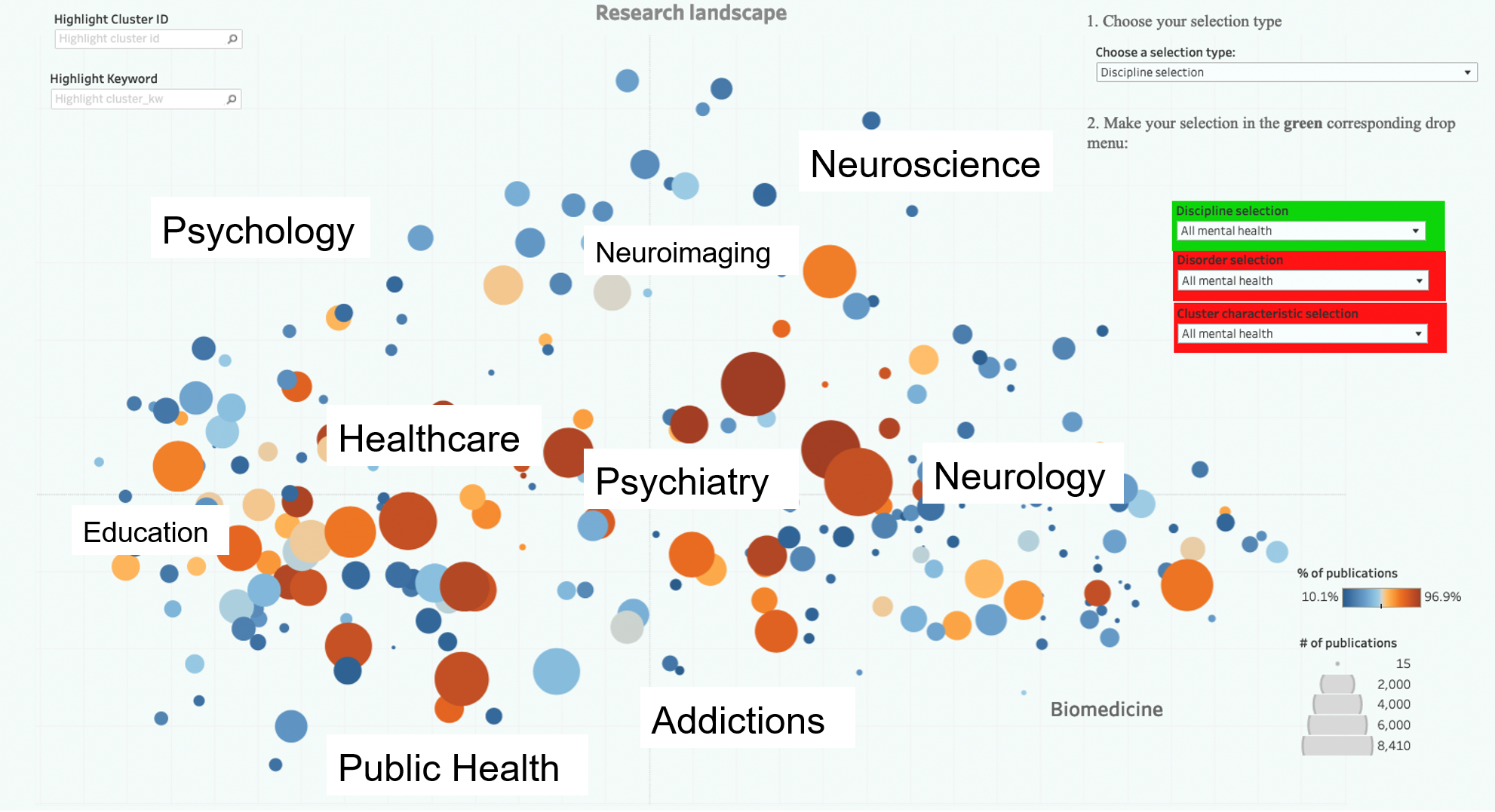Do research priorities for mental health actually reflect the goal of fostering well-being?
Do mental health research priorities reflect societal needs? This post explores the landscape of mental health research and introduces an interactive visualization that allows to explore research portfolios of specific countries, funders and organisations.
This post was previously published on the LSE impact blog.
Mental ill-health and well-being are increasingly recognised as being intimately linked to a wide range of environmental and social factors. As such, the ways in which researchers approach, understand, and engage with mental health must be broad, ranging from the biophysiological mechanisms underpinning brain function, to the societal determinants which alter it. The significance of this connection has been illustrated by the effects of COVID lockdowns on mental health in which: fear, sudden changes in daily habits, family roles, domestic violence, work burnout, etc. have all palpably impinged on mental well-being.
Given this multiplicity of effects, mental health research should consist of a wide diversity of topics, disciplines, approaches, and methods. It also raises the question of prioritisation. To what extent should more research efforts be directed towards prevention, rehabilitation, or understanding the social determinants of health, in comparison with therapeutics or neurosciences? In a collaboration between Vinnova and the Centre for Science and Technology studies (CWTS), we have undertaken a study to begin to understand this diverse research landscape, with the aim of opening up conversations about research priorities. Underlying our analysis is one motivation: how should research be prioritised for the greatest possible reduction of mental ill-health?
We found broad agreement amongst public health researchers and practitioners that mental health is largely determined by environmental, social and economic factors. Factors such as one’s work environment, the natural and built environment (presence of pollution, transportation systems, green spaces, such as parks); one’s relative level of poverty and wealth etc. However, what remains an open question, is the extent to which current research priorities (at the level of scientific fields) are aligned with this understanding. So, do research priorities acknowledge the role of the social and environmental contexts in influencing mental well-being?
To address this, we carried out interviews and focus groups of experts as well as quantitative analyses of publications on mental health. In so doing we built up a picture of what research experts perceive should be prioritised and the current priorities manifest within the published research.
An expert consensus
Our focus groups comprised of discussions with experts, including clinicians, school psychologists, as well as patient representatives. Throughout these exchanges, several key findings emerged with regard to the current priorities of mental health research and their potential disconnect with the needs of the health and welfare systems. A common theme from the interviews was a need for systemic research on the social and environmental determinants of mental health. In particular, experts called for research that is more focused on:
- Health systems and health services
- Psychosocial interventions, rather than only biomedical and pharmaceutical, interventions, as well as diagnostic classifications
- A perspective of mental health that focuses on the entire life-course, with special attention to childhood and adolescence
These points highlight the conclusion of experts that mental health research has become focused on decontextualized individual and biomedical approaches. Further, experts argued that the reason for this focus on biomedical psychiatry and neuroscience, were incumbent authority, recognition, and reward structures within academia, which prioritise funding for ‘novel and highly technical’ approaches. More contextualized forms of research, focused on social determinants were on the other hand felt to be devalued and under-prioritized.
Mapping research priorities from publication data
Alongside this qualitative data, we documented the current distribution of research for mental health across disciplines and topics using publication data (Web of Science) with an interactive visualization interface that allows users to compare research efforts by specific countries, organizations and funders.

The first visualization provides information on the relative amount of research that a given unit (e.g. a country) publishes in certain disciplines, as illustrated in Figure 1. with Germany, United Kingdom and Sweden given as examples. Publication data shows that psychiatry-related disciplines, neurosciences, and biomedicine constitute the largest share of research, with around 60%-75% of all research. It also confirms experts’ perceptions that there is relatively little mental health research in social science, public health and policy, and in healthcare systems, with around 10-20% of publications altogether. According to stakeholders, this low percentage is due to the relative lack of academic prestige of qualitative and implementation research among health funders and evaluation systems. However, Figure 1 also shows that Sweden (and the Nordic countries if you explore the interactive visualisation) has a more balanced portfolio than countries such as Germany or the UK.
The second visualization allows users to compare the relative number of publications of a specific country, organization or funder over 280 research topics related to mental health, as illustrated in Figure 2. With this more detailed description, it is possible to explore particular specialisation patterns – thus spotting research strengths or gaps for a certain country or organization. For example, we were able to see that Sweden is relatively specialised in Alzheimer’s disease, that Denmark is relatively more focused on schizophrenia and bipolar disorder, while the US is more active in autism research. More interestingly, the mappings also show the specific social determinants of mental health studied, e.g. the relationship between racial inequality and mental health, inequalities, school bullying, job insecurity or homelessness.

Facilitating deliberation on research priorities
Our hope is that the comparisons provided by the visualization tools can support deliberations between policymakers and experts so as to rebalance mental health research in ways more effective in reducing the amount of mental ill-health, as well in promoting mental well-being.
Redressing these imbalances in mental health research has the opportunity to better countless lives. Research funders and policymakers, have a responsibility to reflect on whether or not current research priorities truly serve the needs of society.
We thank the editor of the LSE Impact Blog, Michael Taster, for editing suggestions.
Photo credits header image: Emma Simpson






0 Comments
Add a comment